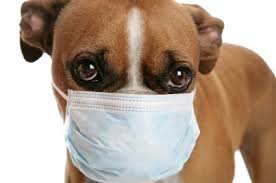What is Bordetella?
Bordetella bronchiseptica is a cause of upper respiratory infection. It is caused by a small, rod-shaped bacterium of the genus Bordetella. It is a type of infectious bronchitis (inflammation of the large airways) found in dogs and other animals, but rarely infects humans.
What are the symptoms?
Bordetella is usually characterized by a loud, deep throated cough or hack. This type of bronchitis may be of brief duration and mild cases usually call for a simple course of oral antibiotics; however, if left untreated, it may progress to a life-threatening pneumonia depending on what additional infectious agents are involved and the immunological strength of the patient.
How can my dog get infected?
Our pets can become infected with Bordetella as easily as you and I can catch the common cold. It often requires close contact such as playing at the dog park, visiting the vet, boarding, or grooming.
Bordetella is a very advanced bacterium which can basically “glue” itself to the hairs, called cilia, lining the animal’s respiratory tract, rendering the cilia unable to move within 3 hours of contact. It also secretes substances that work to combat the body’s immune cells that are in charge of consuming and destroying bacteria.
What happens if my dog gets infected?
Dogs will be infected usually for 1-2 weeks, but the Bordetella organism will continue to be shed from the affected animal for 2-3 months after infection. To reduce the risk of spreading the infection, it is recommended to place the animal in an at-home quarantine for the 3 month duration. They will generally have to be quarantined if staying in any boarding facility, grooming salon, veterinary clinic, etc. and should stay away from any area containing other animals until the 3 month period has passed. Along with this, oral antibiotics are often recommended and the patient may need to start cough suppressants. Treatment normally lasts 1-2 weeks, but may be prescribed for longer durations depending on the severity of the infection.
How do I prevent my dog from becoming infected?
The most effective method of prevention is a simple yearly vaccination provided at every wellness exam, starting from 8 weeks of age. The vaccination sequence starts with an intranasal vaccine (liquid administered into your dog’s nose). The advantage is that the local immunity is stimulated right at the site where natural infection would occur. Some dogs will have some sneezing or nasal discharge in the week following intranasal vaccination; this should clear up on its own. As a general rule, nasal vaccination provides faster immunity than injectable vaccination alone. The intranasal vaccine should have a booster within a month with a subcutaneous injection (under the skin), then annually to prevent infection. Bordetella bronchiseptica vaccination may not completely prevent infection.

